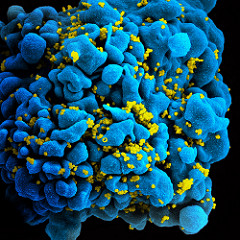Can gene editing drive out HIV and hepatitis viruses from inside cells?
By Cormac Sheridan,
Nature Biotechnology
| 10. 30. 2023
A gene-editing therapy based on CRISPR–Cas9 designed to eliminate HIV-1 infection has rekindled hopes among scientists that it may be possible to eradicate the virus and cure the infection. In an in vivo editing study in non-human primates conducted by scientists from Temple University and Excision BioTherapeutics, a single dose of a CRIPSR therapy excised the simian immunodeficiency virus (closely related to HIV-1) from the DNA of infected animals with no observable off-target effects or other safety problems. The equivalent human therapy, EBT-101, is undergoing a phase 1/2 clinical trial in people infected with HIV-1.
This CRISPR therapy is part of a wave of sophisticated genetic approaches targeting difficult-to-treat chronic infections (Table 1). In addition to gene editing, therapies, including antisense oligonucleotides, short interfering RNA (siRNA), gene therapy, therapeutic vaccines and chimeric antigen receptor (CAR)-T cell therapies, are being brought to bear on a range of pathogens, but most prominently on HIV-1 and chronic hepatitis B virus (HBV) infection.
Once a person is infected and after the acute stage resolves, these viruses can persist indefinitely — in CD4 T...
Related Articles
By Jonathan Matthews, GMWatch | 12.11.2025
In our first article in this series, we investigated the dark PR tactics that have accompanied Colossal Bioscience’s de-extinction disinformation campaign, in which transgenic cloned grey wolves have been showcased to the world as resurrected dire wolves – a...
By Jenny Lange, BioNews | 12.01.2025
A UK toddler with a rare genetic condition was the first person to receive a new gene therapy that appears to halt disease progression.
Oliver, now three years old, has Hunter syndrome, an inherited genetic disorder that leads to physical...
By Simar Bajaj, The New York Times | 11.27.2025
A common cold was enough to kill Cora Oakley.
Born in Morristown, N.J., with virtually no immune system, Cora was diagnosed with severe combined immunodeficiency, a rare genetic condition that leaves the body without key white blood cells.
It’s better...
By Rachel Hall, The Guardian | 11.30.2025
Couples are needlessly going through IVF because male infertility is under-researched, with the NHS too often failing to diagnose treatable causes, leading experts have said.
Poor understanding among GPs and a lack of specialists and NHS testing means male infertility...




